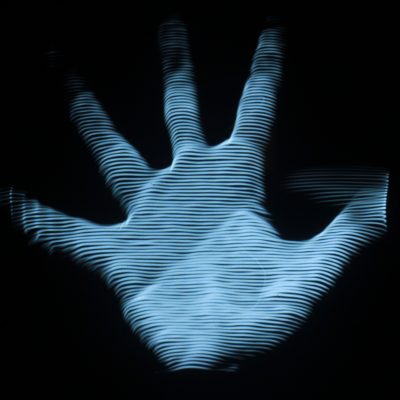Vector Synthesis
While TONEWHEELS used graphics and light to create sound, VECTOR SYNTHESIS uses audio signals to create light images on an analog vector graphics display. It draws on the historical work of artists such as Mary Ellen Bute, John Whitney, Nam June Paik, Ben Laposky, and Steina & Woody Vasulka among many others. It also investigates the history of the computer as a military calculator dedicated to more efficient ways to drop bombs on other human beings, which was slowly appropriated into the service of artistic expression.
In contrast to conventional video monitors, which rasterize an image into a series of pixels along a succession of scan lines, vector monitors (like their close cousin the oscilloscope) employ the unconstrained vertical and horizontal movement of a single beam of light to trace shapes, points and curves with near-infinite resolution.
Vector monitors represent an early phase of the development of video technology, and were initially used to visualize the calculations of analog computers. As Cathode Ray Tube monitors are rapidly replaced by more efficient flatscreens, the look of the CRT becomes an icon at the same time as the object itself becomes e-waste.
This electronic signal-based technique can generate classic Lissajous figures on the oscilloscope or vector monitor, as well as render geometric shapes and 3D models, or use the mathematics of the signals themselves to create what pioneering video artist Woody Vasulka refers to as “time/energy objects”.
Scan processing refers to a video raster manipulation technique whereby the luma or brightness values of any given area of an image are extracted and employed for further transformations — for example by applying it to create three dimensional depth in an otherwise two dimensional image.
The culmination of many of these techniques came together during my work with the vintage EMS Synthi 100 (UK, 1971) analog modular synthesizer at the Electronic Studio of Radio Belgrade.
VECTOR SYNTHESIS was largely developed during studies at the Media Lab of Aalto University (Helsinki FI, 2016-19), as well as during residencies at Cirkulacija2 (Ljubljana SI, 2017), the Electronic Studio of Radio Belgrade (Belgrade SRB, 2018), and the Media Arts and Technology department of the University of California (Santa Barbara USA, 2019). The work has been performed live in 14 countries. In October of 2018, I co-organized the Vector Hack conference and festival of experimental vector graphics in Zagreb and Ljubljana in collaboration with Ivan Marušić Klif and Chris King. And in the summer of 2019, I published the book Vector Synthesis: a Media Archeological Investigation into Sound-Modulated Light in a sold-out edition of 700 copies.


